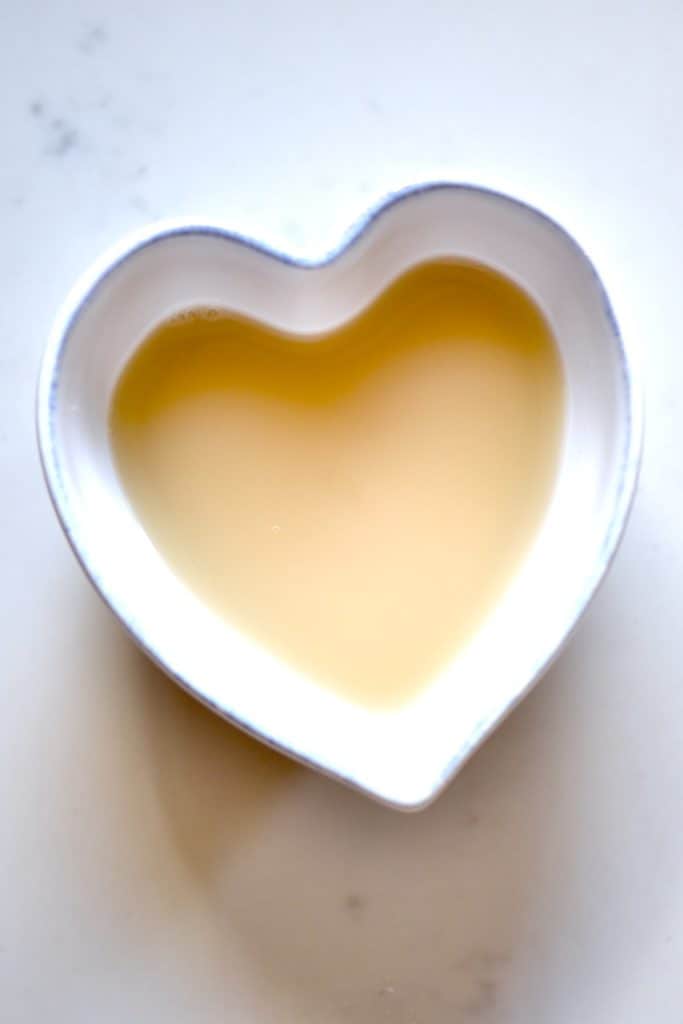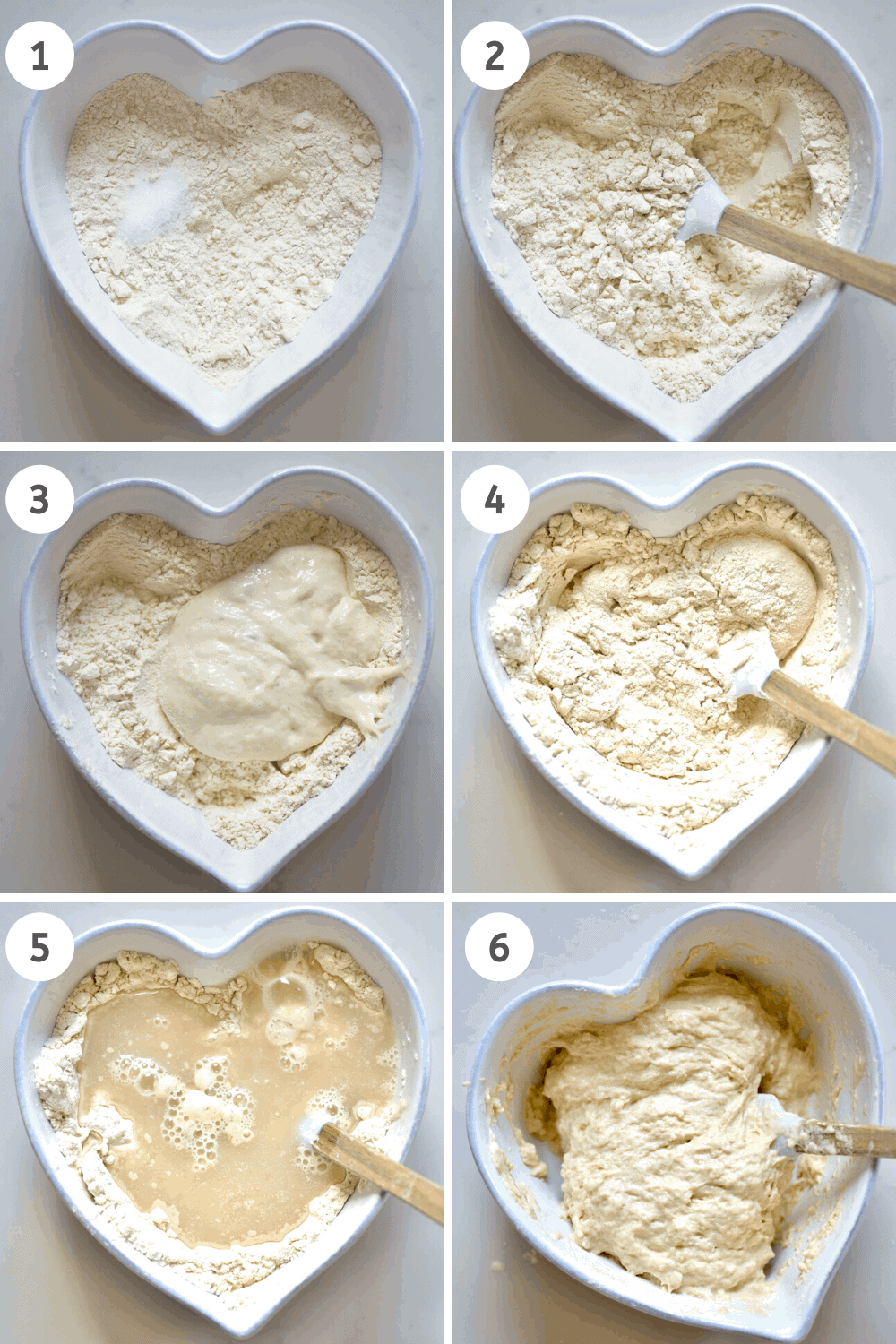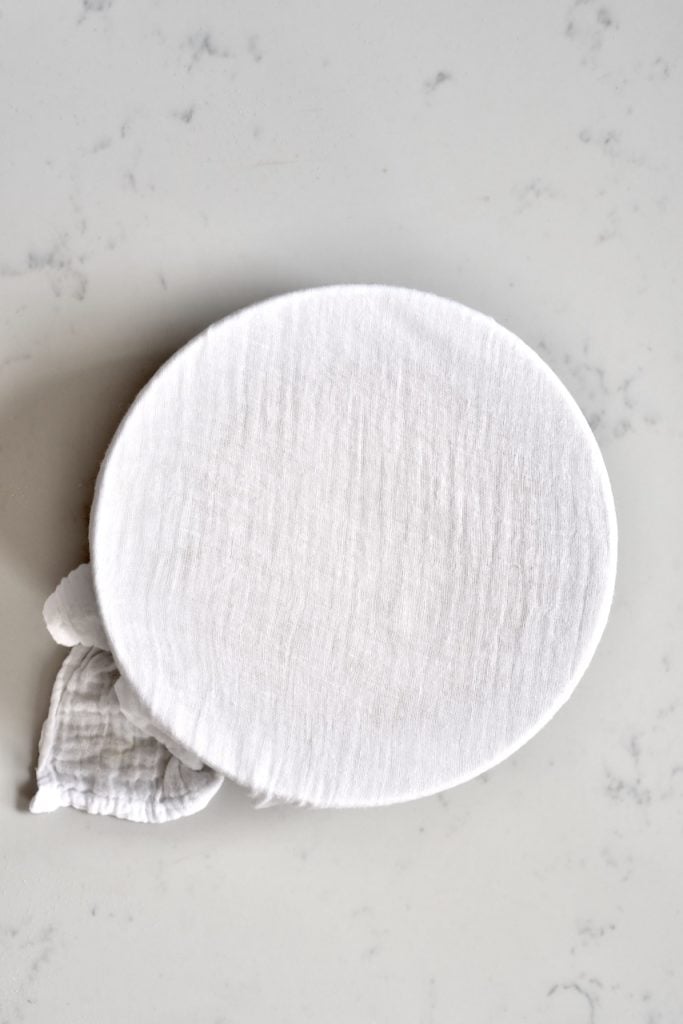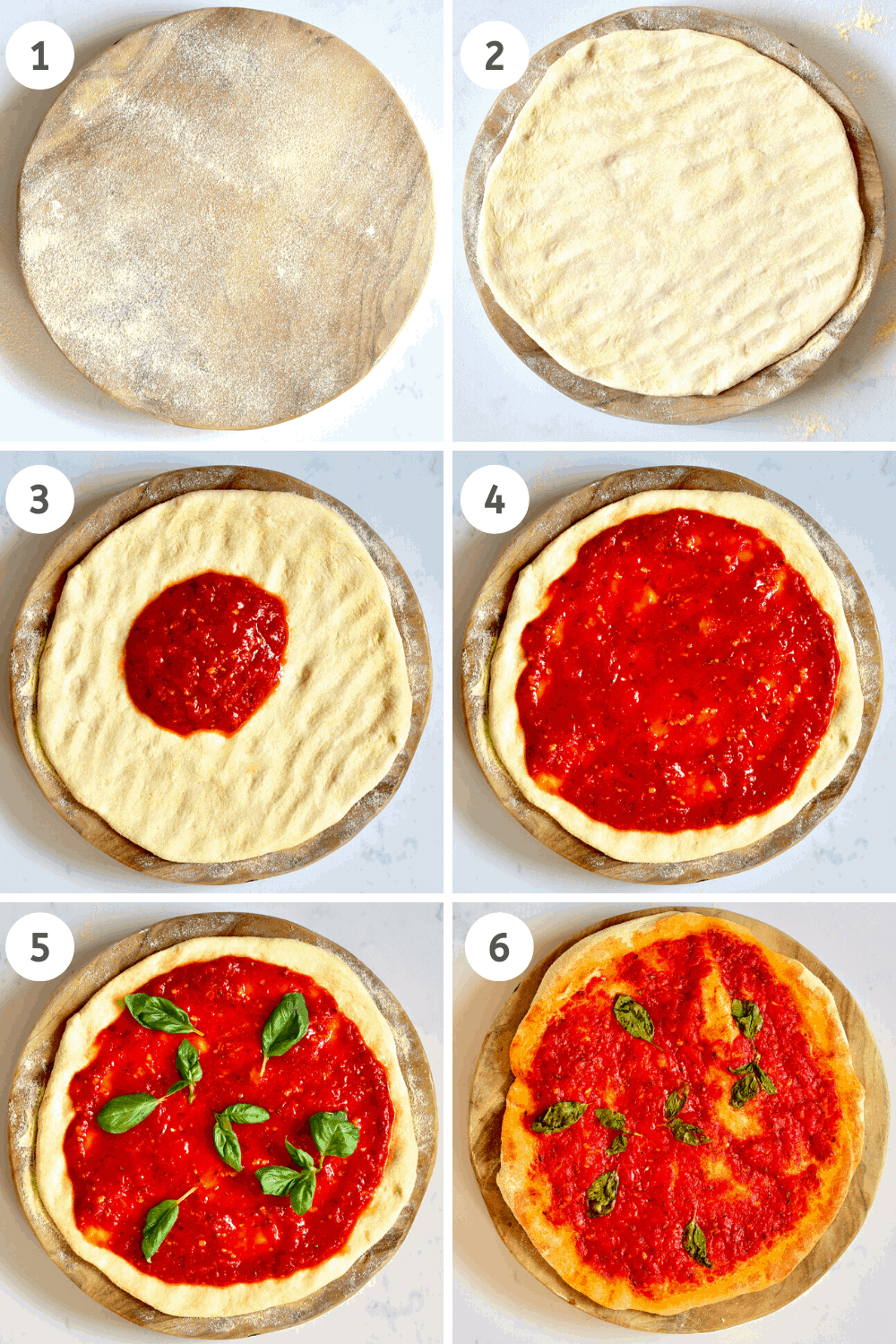This post may contain affiliate links. Please read our disclosure policy.
A delicious homemade Neapolitan pizza marinara style – with a homemade authentic Italian pizza dough recipe, tomato sauce, garlic, and olive oil.

I’ve made pizza before – using quick methods, cheat methods, and more. However, with all this extra time on my hands, I thought it was finally time to learn how to make an authentic Italian-style pizza dough recipe. This Neapolitan Marinara pizza (i.e. “pizza marinara”) recipe is one made with love and one I can’t wait to share with you.
Having learned this process and researching traditional methods, I have a newfound respect for everyone out there taking the time to use authentic Italian pizza methods. No more frozen pizza bases for me; If anything I’m now wishing that I had space for a traditional pizza oven – homemade wood-fired pizza, I wish.
Want to save this recipe?
So what is Neapolitan pizza?
Pizza Napoletana (i.e. Neapolitan pizza) is a type of thin-crust pizza originating from Naples in Italy. Using a special dough preparation and simple, fresh toppings. For this blog post, I decided to make a ‘marinara pizza’ version, which omits cheese (although I did add a cheeky sprinkle of basil leaves because I love them).

This style of pizza is also usually “wetter” than your standard pizza, and harder to eat in slices if you use the perfect ratio of sauce to dough (and cheese, if using it).
There are actually four main varieties of Neapolitan pizza, including:
- Marinara Pizza: With tomato, garlic, oregano, and extra-virgin olive oil (EVOO)
- Margherita: With tomato, sliced fresh mozzarella Fiore di latte (rather than grated), basil, and EVOO.
- Margherita Plus: Similar to the above but uses buffalo mozzarella from Campania instead of the Fiore di latte.
- Pizza Bianca: This is “white pizza” and is served without tomato sauce. I’ve read differing versions on what the “authentic” pizza Bianca contains – it seems to be one that is served more as bread than a pizza, with herbs olive oil, and garlic.

Now, while the homemade pizza dough has been made following the traditional Neapolitan method with a ‘poolish’, I’m unable to follow the rules for a perfectly authentic Neapolitan pizza (of which, there are many). These dictate exactly what flour to use, where to source ingredients, how it’s kneaded, the use of fresh yeast, and the exact cooking method (in a wood fire oven for under 90 seconds), just to name a few.

Unfortunately, without the use of a wood fire oven or access to the regional ingredients, there was no hope for full authenticity – so I did what I could by focusing on doing the best dough I could. To make this authentic Italian pizza dough recipe, we first need to make what is called a poolish.
What is poolish and why use one?

Poolish is a type of yeast-based preferment that is left to ferment slowly over a long period of time and used within pizza and bread recipes. This longer fermentation adds more flavour to the dough and affects the texture too, with a chewier crust.
It might sound a bit complicated, but making poolish is a simple and mixing together a few ingredients (flour, water, and yeast) and leaving it to ferment – super simple. I like to do this late at night, so I can leave it to ferment overnight and I’m ready to use it the next day.


In fact, some even take this to another level by then placing their pizza dough in the fridge for a slow rise too. This combination of poolish and slow fermentation adds buckets of flavor to your dough, according to the professionals.
There are arguments about whether or not you need to use fresh yeast or dry yeast for this with pros and cons for both sides. Personally, I suggest using what you have available to you. For many, I know that dry yeast is easier to get ahold of and since we’re not all professionals – I’m okay with these types of ‘cheats’.

However, it is worth noting that the ratio between dry yeast and fresh yeast will be different (listed below in the recipe).
The Neapolitan Pizza How-To
For the poolish:

- yeast (dried or fresh)
- lukewarm water
- white bread flour (or normal plain white flour)
For the dough:

- yeast (dried or fresh)
- white all-purpose flour/ bread flour, salt, lukewarm water
- a sprinkle of polenta or semolina
Note- traditionally a 00 Italian bread flour is used, but this is hard to source here.
For the sauce:

- olive oil, garlic cloves
- tinned red tomatoes or passata
- sugar (I used brown sugar), salt, black pepper, dried oregano
Steps:
First, to make the poolish, mix the yeast and warm water, making sure that all the yeast has dissolved. Add this to the flour, mix and cover with a tea towel. Set aside for at least 8 hours. However, this is best left for between 18-24 hours, if you have the patience.
Note: if you are using dry yeast, leave it outside the fridge. If you are using fresh yeast, then place it in the fridge.
The poolish is ready when it has a bubbly and stretchy texture.


Once the poolish is ready, prepare the pizza dough. In a large bowl, combine the salt and flour and mix. Once again add the yeast to water, making sure it dissolves completely.


Mix the poolish and new yeast mixture into the bowl, until a sticky dough forms.

Transfer the dough onto a lightly floured surface.

Knead the dough for about 10 minutes.

It needs to become soft and elastic.

Shape into a ball and place it into a pre-greased bowl. Cover with a tea towel and set aside for 1 hour while the dough rises.
If you’ve made enough dough for multiple pizzas then once risen, it can be portioned and stored in an airtight container in the fridge for up to four days. Simply remove from the fridge a couple of hours before baking.



In the meantime, heat up your oven and prepare the tomato sauce.
Place a pizza stone OR inverted baking pan in the middle of the oven. Preheat the oven to the highest temperature it could go (e.g mine goes up to 250ºC).
Note: it’s important that the baking tray/pizza stone is inside the oven while it is heating up.
To make the pizza sauce first fry the garlic with the olive oil over medium heat for about 30 seconds in a large pan.
Add the tomatoes and simmer for a few minutes with a lid on. Add the salt, pepper, and sugar and stir for a couple more minutes. Finally, add the oregano, stir well, and switch off the heat.

Use a baking sheet under your pizza in the absence of a big pizza spatula/peel. This is essential when the pizza needs to be transferred quickly to the oven without collapsing.
Sprinkle some semolina/polenta (or flour) on the baking sheet.
Roll the dough ball into a big pizza circle (around 20-25 cm/8-10″ depending on preferred thickness) for your pizza crust.
Add the pizza sauce, basil leaves, and when you are ready to bake the pizza, make sure the oven is as hot as possible.

Carefully transfer the pizza to the oven and bake for about 9 minutes.
If you want to add some cheese (like this Easy Stretchy Vegan Mozzarella Cheese), do so in the last few minutes of baking the pizza. Adding the cheese later is necessary so that the dough under the cheese doesn’t become soggy – we want the whole pizza to bake evenly.

As soon as you are happy with the look of the pizza, take it out of the oven. Optionally, you could now drizzle with a little bit of an infused olive oil such as chili oil or garlic oil – however, this is not necessary at all.

More Pizza Recipes
If you try this recipe, let me know how it goes in the comments below. I’d appreciate a recipe card rating and would love to see your recipe recreations – tag me on Instagram @Alphafoodie!

How to make Neapolitan pizza (Marinara style)
Ingredients
For the poolish:
- 1/2 tsp dried yeast or 1 gr fresh yeast
- 25 ml water lukewarm/tepid
- 1/4 cup white bread flour or normal plain white flour
For the dough:
- 1 tsp dried yeast 2 gr fresh yeast
- 1 cup white flour 125 gr
- 1/2 tsp salt
- 6 tBsp water Lukewarm/tepid
- a sprinkle of polenta or semolina or white flour
For the sauce:
- 1 tBsp olive oil
- 2 garlic cloves 1 tsp minsed garlic
- 1 cup tinned red tomatoes or passata
- 1/4 tsp sugar brown sugar is an option
- 1/2 tsp salt
- 1/4 tsp black pepper
- 1/2 tsp dried oregano
- Optional: drizzle of chilli or garlic olive oil
Instructions
- To make the poolish, mix the yeast and warm water, making sure that all the yeast has dissolved. Add this to the flour, mix and cover with a tea towel.
- Set aside for at least 8 hours. However, this is best left for between 18-24 hours, if you have the patience.* The poolish is ready when it has a bubbly and stretchy texture.
- Once the poolish is ready, prepare the pizza dough. In a large bowl, combine the salt and flour and mix. Once again add the yeast to water in a separate small bowl, making sure it dissolves completely.
- Mix the poolish and new yeast mixture into the bowl, until a sticky dough forms.
- Transfer the dough onto a lightly floured surface and knead the dough for about 10 minutes until soft and elastic. (this is a wet, sticky dough to begin with)
- Shape into a ball and place into a pre-greased bowl. Cover with a tea towel and set aside for 1 hour while the dough rises.
- Place a pizza stone OR inverted baking pan in the middle of the oven. Preheat the oven to the highest temperature it could go (e.g mine goes up to 250ºC).**
- To make the pizza sauce first fry the garlic with the olive oil over medium heat for about 30 seconds in a large pan.
- Add the tomatoes and simmer for a few minutes with a lid on. Add the salt, pepper and sugar and stir for a couple more minutes. Finally, add the oregano, stir well and switch off the heat.
- Use some parchment paper or a baking sheet under your pizza in the absence of a big pizza spatula/peel. This is essential when the pizza needs to be transferred quickly to the oven without collapsing. Sprinkle some semolina/polenta (or flour) on the baking sheet.
- Roll the dough ball into a big pizza circle (around 20-25 cm/8-10" depending on preferred thickness) for your pizza crust.
- Add the pizza sauce, basil leaves, and when you are ready to bake the pizza, make sure the oven is as hot as possible.
- Carefully transfer the pizza to the oven and bake for about 9 minutes. If you want to add some mozzarella, do it the last few minutes of baking the pizza.
- As soon as you are happy with the look of the pizza, take it out of the oven. Optionally, you could now drizzle with a little bit of an infused olive oil such as chilli oil or garlic oil – however, this is not necessary at all.
Your pizza is now ready to enjoy!
Notes
- *Poolish preparation: if you are using dry yeast, leave it outside the fridge. If you are using fresh yeast, then place it in the fridge.
- **Preheating the oven: it’s important that the baking tray/pizza stone is inside the oven while it is heating up.
- If you’ve made enough dough for multiple pizzas then once risen, it can be portioned and stored in an airtight container in the fridge for up to four days. Simply remove from the fridge a couple of hours before baking.
Nutrition
Nutrition information is automatically calculated, so should only be used as an approximation.










Could I make this same recipe with spelt flour ?
Hi Lin, of course you can!
Hiiiii!! Hope you’re well! I realllly want to make this pizza recipe! It will be my very first pizza
Do you think it’s easy to make for such a beginner?
I was wondering it said it yields one pizza? How big is the pizza? And if I wanted to make more than one, For 2, double, for 3 triple and so on?? Also for the sauce can I use just regular tomatoes?
Thank you and hope you can reply soon! I would love to start today!
Hi Dima,
You should be fine if you read through the steps and follow the recipe. You can always double or triple the recipe, to make more pizzas. Once you’ve made enough dough, you can store the excess dough once risen, in portions in an airtight container in the fridge for up to four days if you don’t bake it on the same day. Just remove the dough from the fridge until it reaches room temperature before baking. One pizza is about 20-25cm/8-10” depending on your preferred thickness.
You can use regular tomatoes if you peel them. I hope this helps.
Hi there
Can I use fresh tomatoes instead of tinned? The quality of tinned tomatoes in my country isn’t great
Thanks x
Yes, you can 🙂 – just make sure to simmer them for a long time over heat, to reduce and thicken 🙂